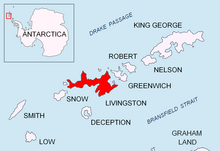



Pliska Ridge (Bulgarian: връх Плиска, romanized: vrah Pliska, IPA: [ˈvrɤx ˈpliskɐ]) is a three-peaked ridge rising to 667 m (2,188 ft) in eastern Livingston Island in the South Shetland Islands, Antarctica. Its central and highest summit, Pliska Peak, is located 2.48 km (1.54 mi) east-northeast of Willan Nunatak (449 m (1,473 ft)), 1.81 km (1.12 mi) southeast of Burdick Peak (773 m (2,536 ft), summit of Burdick Ridge), 3.53 km (2.19 mi) south-southwest of Mount Bowles, 3.68 km (2.29 mi) west-southwest of Kuzman Knoll, and 3.61 km (2.24 mi) northwest of Mount Friesland. The feature is 1.6 km (0.99 mi) long and 500 m (1,600 ft) wide, its axis trending due east-west, with precipitous southern slopes. It is ice-covered except for segments of its easternmost peak (646 m (2,119 ft)) and is bounded to the northwest by Orpheus Gate, to the north by the head of Perunika Glacier, to the east by Nesebar Gap, and to the south and west by the head of Huntress Glacier, the latter flowing 6 km (3.7 mi) southwestwards into False Bay.
First ascent by the Bulgarian Lyubomir Ivanov from Camp Academia on 18 December 2004.
Pliska is the name of a settlement in north-eastern Bulgaria, which in the seventh century became the capital of the First Bulgarian Empire.